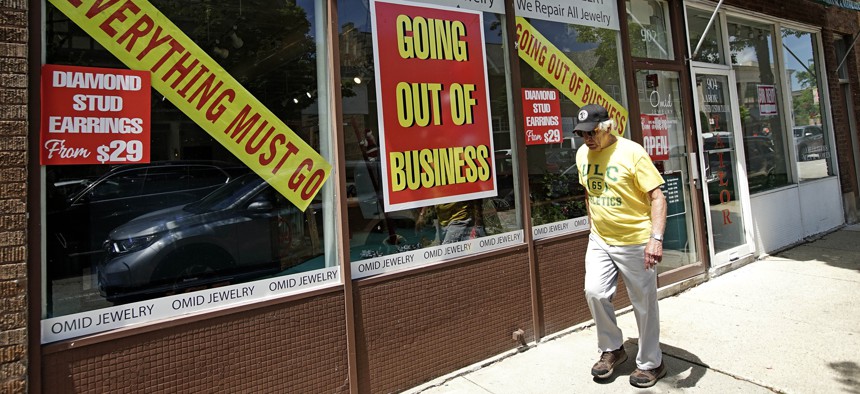New Unemployment Benefits Could Take Weeks to Distribute

A man walks past a retail store that is going out of business due to the coronavirus pandemic in Winnetka, Ill., Tuesday, June 23, 2020. AP Photo/Nam Y. Huh
Thirty-two states have been approved for the federal unemployment program, but only four states have begun issuing the $300-a-week benefits.
Out of work Americans may end up waiting several more weeks before they begin to receive the extra unemployment benefits President Trump approved this month through executive action.
While 32 states have been approved for the Lost Wages Assistance Program funded by Federal Emergency Management Agency dollars, only four states—Arizona, Louisiana, Missouri and Texas—have begun to issue payments.
Even when unemployed workers do begin receiving the unemployment supplements, they will receive only about half of the amount collected under the prior federal program. And payments may last for a much shorter time than initially expected, said Andrew Stettner, a senior fellow and expert on unemployment insurance at The Century Foundation.
States stopped issuing the $600-a-week federal unemployment benefits at the end of July after Congress and the Trump administration were unable to come to agreement on a coronavirus pandemic aid package.
Under Trump’s executive order, unemployed workers can receive $400 a week in federal benefits on top of the usual state-paid benefits. The federal government would fund $300 for the additional payment but states would be required to cover the remaining $100.
Facing their own financial hardships, most states have opted to only take the federal payment and not to contribute their own portion, meaning most workers would receive half of what they were previously paid.
Arizona was the first state in the country to begin issuing benefits through the program—last week the state distributed two weeks worth of retroactive benefits to approximately 400,000 people, said Brett Bezio, spokesman for the state’s Department of Economic Security. Of $1.1 billion in unemployment benefits the state paid out last week, it distributed $252 million in federal supplemental payments.
“We recognized the need in our community for this additional assistance and worked as swiftly as possible with FEMA and the Department of Labor to make the necessary system changes,” Bezio said. “Toward the beginning of the pandemic, we implemented a brand-new system for Pandemic Unemployment Assistance, which we developed with flexibility for these kinds of changes.”
Texas began processing payments on Sunday, issuing retroactive payments covering the first three weeks in August. Louisiana this week announced it would begin distributing payments, including backpay, on Wednesday. That same day, Missouri, too, announced it had begun processing the supplemental benefits.
But other states expect it will take much longer to begin distributing benefits because of restrictions on the funding. States cannot distribute the new round of funds through their existing unemployment systems, and the new program has different guidelines that could exclude some people who were able to collect the $600-a-week benefits.
“It’s taking them some time to get this going,” Stettner said.
Unemployment agencies in both Colorado and Maryland indicated it could be the end of September before they are able to begin distributing payments.
New Jersey officials announced Wednesday that the state would apply for the federal program, but said it was unlikely payments would be distributed until October.
South Dakota is the only state to turn down the federal assistance. Gov. Kristi Noem said the state has been able to bounce back from the coronavirus pandemic and that 80 percent of the jobs lost during the outbreak have been recovered.
Funding for the supplemental benefits is coming from FEMA’s Disaster Relief Fund. While the payments are authorized through December, experts say the $44 billion fund will only be able to sustain the unemployment benefits program for a few weeks.
Potentially complicating matters is the category 4 hurricane bearing down on the Gulf Coast. The FEMA disaster fund is typically used for relief efforts after a natural disaster and the unemployment program could be cut at any moment if the funding is needed for that purpose.
To accurately assess the funding available, FEMA is initially authorizing only three weeks of funding at a time to states. After that, states must reapply weekly.
The uncertainty of how long benefits will last creates hardships for the millions of Americans who remain unemployed, Stettner said.
“There is a real urgency to get a real federal supplement approved,” he said.
Editor's note: This story was updated to reflect that Louisiana and Missouri announced the states would begin processing payments on Wednesday.
Andrea Noble is a staff correspondent with Route Fifty.
NEXT STORY: In New Jersey, a Proposal for $1,000 ‘Baby Bonds’





